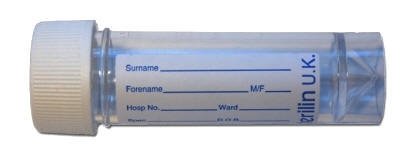Laxative Screen
Chemical Pathology
Notes
- Laxatives are widely used to manage constipation but laxative-induced diarrhoea is a well recognised clinical entity which may need to be excluded before other costly or invasive gastrointestinal investigations are performed.
- There are 4 main forms of laxatives, bulk forming, stimulant, osmotic and faecal softeners.
- Urine can be screened for the most common stimulant laxatives (bisacodyl, danthron, rhein and phenolphthalein) using GCMS methodology.
- Random urine samples collected on 2 or 3 consecutive days coinciding with a period of diarrhoea is probably the most useful approach.
Sample requirements
10 - 15 mL urine collected into a plain 30mL Universal

Storage/transport
Send at ambient temperature to the laboratory. If unavoidable, samples can be stored refrigerated overnight.
Required information
Relevant clinical details, including reason for the request and current stool appearance.
Turnaround times
The samples are sent for analysis to the Regional Toxicology Laboratory at Birmingham City Hospital with results expected back within 2 weeks.
Reference ranges
Results reported as detected or not-detected.
Further information
For information on laxatives visit Patient.co.uk